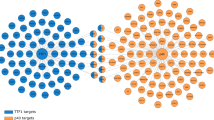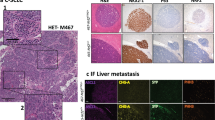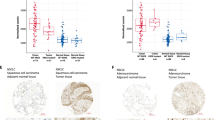Abstract
The transcription factor E2F-1 plays a crucial role in the control of cellular growth. We previously reported its differential pattern of expression in human lung tumors. In this study, we have investigated the relationships linking the status of E2F-1 and a mediator of its proteasomal degradation, the S-phase kinase-associated protein 2 (Skp2) F-box protein. Using immunohistochemistry in a series of 129 lung tumors of all histological types, we demonstrate that Skp2 accumulates preferentially in high-grade neuroendocrine (HGNE) lung carcinomas (86%, P<0.0001), and show that Skp2 overexpression is associated with advanced stages (P<0.0001) and nodal metastasis (P<0.0001) in neuroendocrine (NE) lung tumors. Unexpectedly, we observe that Skp2 and E2F-1 expression directly correlates in NE lung tumors (P<0.0001). Moreover, using cellular models, we identify Skp2 as a new E2F-1 transcriptional target. Furthermore, we also provide evidence that Skp2 interacts physiologically with E2F-1 and stimulates its transcriptional activity toward the cyclin E promoter. Consistently, we demonstrate that cyclin E expression directly correlates with Skp2 (P<0.0001) and E2F-1 (P=0.0001) status in NE lung tumors. Overall, our data provide the first evidence of a direct and functional interconnection between the E2F-1, Skp2 and cyclin E oncoproteins in HGNE lung carcinomas.
This is a preview of subscription content, access via your institution
Access options
Subscribe to this journal
Receive 50 print issues and online access
$259.00 per year
only $5.18 per issue
Buy this article
- Purchase on Springer Link
- Instant access to full article PDF
Prices may be subject to local taxes which are calculated during checkout





Similar content being viewed by others
References
Bai C, Sen P, Hofmann K, Ma L, Goebl M, Harper JW et al. (1996). SKP1 connects cell cycle regulators to the ubiquitin proteolysis machinery through a novel motif, the F-box. Cell 86: 263–274.
Brambilla E, Gazzeri S, Moro D, Caron de Fromentel C, Gouyer V, Jacrot M et al. (1993). Immunohistochemical study of p53 in human lung carcinomas. Am J Pathol 143: 199–210.
Brambilla E, Moro D, Gazzeri S, Brambilla C . (1999). Alterations of expression of Rb, p16(INK4A) and cyclin D1 in non-small cell lung carcinoma and their clinical significance. J Pathol 188: 351–360.
Carrano AC, Eytan E, Hershko A, Pagano M . (1999). SKP2 is required for ubiquitin-mediated degradation of the CDK inhibitor p27. Nat Cell Biol 1: 193–199.
DeGregori J . (2002). The genetics of the E2F family of transcription factors: shared functions and unique roles. Biochim Biophys Acta 1602: 131–150.
Deshaies RJ . (1999). SCF and cullin/ring H2-based ubiquitin ligases. Annu Rev Cell Dev Biol 15: 435–467.
Eymin B, Gazzeri S, Brambilla C, Brambilla E . (2001a). Distinct pattern of E2F1 expression in human lung tumours: E2F1 is upregulated in small cell lung carcinoma. Oncogene 20: 1678–1687.
Eymin B, Karayan L, Seite P, Brambilla C, Brambilla E, Larsen CJ et al. (2001b). Human ARF binds E2F1 and inhibits its transcriptional activity. Oncogene 20: 1033–1041.
Ginsberg D . (2002). E2F1 pathways to apoptosis. FEBS Lett 529: 122–125.
Gouyer V, Gazzeri S, Bolon I, Drevet C, Brambilla C, Brambilla E . (1998). Mechanism of retinoblastoma gene inactivation in the spectrum of neuroendocrine lung tumors. Am J Respir Cell Mol Biol 17: 1–9.
Gstaiger M, Jordan R, Lim M, Catzavelos C, Mestan J, Slingerland J et al. (2001). Skp2 is oncogenic and overexpressed in human cancers. Proc Natl Acad Sci USA 98: 5043–5048.
Harbour JW, Dean DC . (2000). The Rb/E2F pathway: expanding roles and emerging paradigms. Genes Dev 14: 2393–2409.
Kim SY, Herbst A, Tworkowski KA, Salghetti SE, Tansey WP . (2003). Skp2 regulates Myc protein stability and activity. Mol Cell 11: 1177–1188.
Marti A, Wirbelauer C, Scheffner M, Krek W . (1999). Interaction between ubiquitin-protein ligase SCFSKP2 and E2F-1 underlies the regulation of E2F-1 degradation. Nat Cell Biol 1: 14–19.
Nakayama K, Nagahama H, Minamishima YA, Matsumoto M, Nakamichi I, Kitagawa K et al. (2000). Targeted disruption of Skp2 results in accumulation of cyclin E and p27(Kip1), polyploidy and centrosome overduplication. EMBO J 19: 2069–2081.
Nakayama K, Nagahama H, Minamishima YA, Miyake S, Ishida N, Hatakeyama S et al. (2004). Skp2-mediated degradation of p27 regulates progression into mitosis. Dev Cell 6: 661–672.
Nakayama KI, Nakayama K . (2006). Ubiquitin ligases: cell-cycle control and cancer. Nat Rev Cancer 6: 369–381.
Osoegawa A, Yoshino I, Tanaka S, Sugio K, Kameyama T, Yamaguchi M et al. (2004). Regulation of p27 by S-phase kinase-associated protein 2 is associated with aggressiveness in non-small-cell lung cancer. J Clin Oncol 22: 4165–4173.
Salon C, Eymin B, Micheau O, Chaperot L, Plumas J, Brambilla C et al. (2006). E2F1 induces apoptosis and sensitizes human lung adenocarcinoma cells to death-receptor-mediated apoptosis through specific downregulation of c-FLIP(short). Cell Death Differ 13: 260–272.
Soucek T, Pusch O, Hengstschlager-Ottnad E, Adams PD, Hengstschlager M . (1997). Deregulated expression of E2F-1 induces cyclin A- and E-associated kinase activities independently from cell cycle position. Oncogene 14: 2251–2257.
Takanami I . (2005). The prognostic value of overexpression of Skp2 mRNA in non-small cell lung cancer. Oncol Rep 13: 727–731.
Travis WD, Colby TV, Corrin B, Shimosato Y, Brambilla E . (1999). WHO International Histological Classification of Tumours: Histological Typing of Lung and Pleural Tumours, 3rd edn. Springer: Berlin, Germany.
Vernell R, Helin K, Muller H . (2003). Identification of target genes of the p16INK4A-pRB-E2F pathway. J Biol Chem 278: 46124–46137.
Von der Lehr N, Johansson S, Wu S, Bahram F, Castell A, Cetinkaya C et al. (2003). The F-box protein Skp2 participates in c-Myc proteosomal degradation and acts as a cofactor for c-Myc-regulated transcription. Mol Cell 11: 1189–1200.
Yeh KH, Kondo T, Zheng J, Tsvetkov LM, Blair J, Zhang H . (2001). The F-box protein SKP2 binds to the phosphorylated threonine 380 in cyclin E and regulates ubiquitin-dependent degradation of cyclin E. Biochem Biophys Res Commun 281: 884–890.
Yokoi S, Yasui K, Mori M, Iizasa T, Fujisawa T, Inazawa J . (2004). Amplification and overexpression of SKP2 are associated with metastasis of non-small-cell lung cancers to lymph nodes. Am J Pathol 165: 175–180.
Yokoi S, Yasui K, Saito-Ohara F, Koshikawa K, Iizasa T, Fujisawa T et al. (2002). A novel target gene, SKP2, within the 5p13 amplicon that is frequently detected in small cell lung cancers. Am J Pathol 161: 207–216.
Zhang H, Kobayashi R, Galaktionov K, Beach D . (1995). p19Skp1 and p45Skp2 are essential elements of the cyclin A-CDK2 S phase kinase. Cell 82: 915–925.
Zhang L, Wang C . (2006). F-box protein Skp2: a novel transcriptional target of E2F. Oncogene 25: 2615–2627.
Zheng N, Schulman BA, Song L, Miller JJ, Jeffrey PD, Wang P et al. (2002). Structure of the Cul1-Rbx1-Skp1-F boxSkp2 SCF ubiquitin ligase complex. Nature 416: 703–709.
Zhu CQ, Blackhall FH, Pintilie M, Iyengar P, Liu N, Ho J et al. (2004). Skp2 gene copy number aberrations are common in non-small cell lung carcinoma, and its overexpression in tumors with ras mutation is a poor prognostic marker. Clin Cancer Res 10: 1984–1991.
Acknowledgements
We thank Kristian Helin for providing us with the plasmid encoding E2F-1, Didier Trouche for the plasmid pGL2-cyclin E, Lars-Gunnar Larsson for the pcDNA3-Myc-Skp2 and Günter Schneider (Technical University of Munich, Munich, Germany) for the plasmid Skp2-luc. We thank Patricia Betton, Pascal Perron, Sylvie Veyrenc and Aurelie Micoud for technical assistance. This work was supported by grants from the Region Rhône Alpes (Thématique Prioritaire Cancer and Canceropole 2003: Oncocell, Epimed and INACancer) and by the Ligue Nationale contre le Cancer (Equipe Labellisée). CS was supported by a ‘poste accueil’ INSERM.
Author information
Authors and Affiliations
Corresponding author
Additional information
Supplementary Information accompanies the paper on the Oncogene website (http://www.nature.com/onc).
Supplementary information
Rights and permissions
About this article
Cite this article
Salon, C., Merdzhanova, G., Brambilla, C. et al. E2F-1, Skp2 and cyclin E oncoproteins are upregulated and directly correlated in high-grade neuroendocrine lung tumors. Oncogene 26, 6927–6936 (2007). https://doi.org/10.1038/sj.onc.1210499
Received:
Revised:
Accepted:
Published:
Issue Date:
DOI: https://doi.org/10.1038/sj.onc.1210499
Keywords
This article is cited by
-
Securin overexpression correlates with the activated Rb/E2F1 pathway and histone H3 epigenetic modifications in raw areca nut-induced carcinogenesis in mice
Cancer Cell International (2022)
-
VEGF165b, a splice variant of VEGF-A, promotes lung tumor progression and escape from anti-angiogenic therapies through a β1 integrin/VEGFR autocrine loop
Oncogene (2019)
-
Targeting phospho-MARCKS overcomes drug-resistance and induces antitumor activity in preclinical models of multiple myeloma
Leukemia (2015)
-
A dedicated microarray for in-depth analysis of pre-mRNA splicing events: application to the study of genes involved in the response to targeted anticancer therapies
Molecular Cancer (2014)
-
Metabolic and protein interaction sub-networks controlling the proliferation rate of cancer cells and their impact on patient survival
Scientific Reports (2013)



